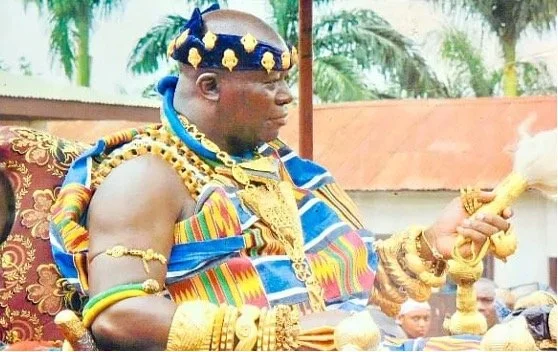AMC Newton for QHQ
The fourth part of our Textile Inspiration series takes us to Africa, to Ghana, and kente/kete cloth. This colourful textile, in its original form, is narrow strips of woven fabric which are sewn together. Traditionally made from cotton and silk, the fabric is said to have originated with the Ewes and Ashanti peoples and was worn by royalty. Nowadays, rayon often replaces silk and the fabric is worn by Ghanaians for special occasions. The fabric strips are woven on narrow hand looms as shown in Fig 1.
According to Dr Anthony Dotse writing in Modern Ghana, the origin of the word ‘kete’ most likely developed from ‘ke’ and ‘te’ linked to the two alternate actions of the loom: “ke (spread or open) and te (tighten or press)” which later evolved into ‘kete” and was corrupted to “kente”. Dr Dotse proposes that “kete” is preferred name for this material, although “kente” seems to have been more widely adopted.
One fascinating aspect of the kete or kente cloth is the meaning and symbolism, not just of the colours, but of the patterns. In a House Beautiful article, Gabrielle Davenport writes about one such pattern which can be seen in Fig 2:
“an oft-used kente pattern is, in Twi, Woforo dua pa a na yepia wo. It means "when you climb a good tree you are given a push;" put another way, when one takes up a worthy cause, one will be supported by their community.”
Fig 2. Pattern Woforo dua pa a na yepia wo
As mentioned in addition to the patterns each colour carries a symbolism, according to the website kentecloth.com here is a colour guide:
Black - Becoming mature & spiritual energy. Symbolising intense spiritual & mental fortitude, encapsulating the essence of wisdom, learning & the transformative journey of life.
Blue - Peacefulness, harmony & love. Embodying the gentle rhythm of the sea & sky, signalling contentment & spiritual abundance.
Green - Growth, renewal & fertility. Reminiscent of the lush vegetation of Ghana, symbolising potential for growth, prosperity and progress.
Gold - Royalty, wealth & high status. Elegance, high value & spiritual purity
Red - Political & spiritual moods, sacrifice & struggle. It’s a powerful symbol of passion, blood, and remembrance of ancestors.
White - Purity, sanctity and is often associated with festive occasions & joyous milestones. Reflecting the quintessential nature of spirituality, purity & righteousness.
Following are images of different kete or kente cloths, as you can see there are a rich array of colours and patterns. Nowadays you can still find traditional woven kete/kente cloth being produced in Ghana. Additionally, there are less expensive printed versions now being offered. There is a debate about whether people should buy and wear these kete/kente patterns outside of Ghana. There are copyright laws in Ghana that protect both the patterns and processes. Outside of Ghana it is debated whether the fabrics should be used. It is recommended to reference the heritage and roots of any kete or kente cloth style textile; perhaps this is an opportunity to educate people about this fascinating and culturally rich textile?
Whether you choose to call it kete or kente cloth it is a textile which inspires and show a real depth of symbolism and meaning, to which we have only scratched the surface here. Please do let us know of any knowledge or experience you have of kete/kente cloth!
Fig 3. Ewe kete stripes.
Fig 4. Kente/Kete cloth patterns
Fig 5. Kete/kente cloth on handloom
Source: Kojooooooo on Pixabay
Fig 6. Otumfuo Osei Tutu II, King of the Ashanti region
wearing kete/kente cloth
Further Reading
Books:
African Textiles, Hardcover by Duncan Clarke, et al (2022)
Kente Cloth: History and Culture, by Ernest Asamoah-Yaw (2017)
Fashion Africa by Jacqueline Shae (2011)
The copyright thing doesn't work here: Adinkra and Kente cloth and intellectual property in Ghana by Boatema Boateng (2011)
Articles:
https://www.africanfabric.co.uk/







